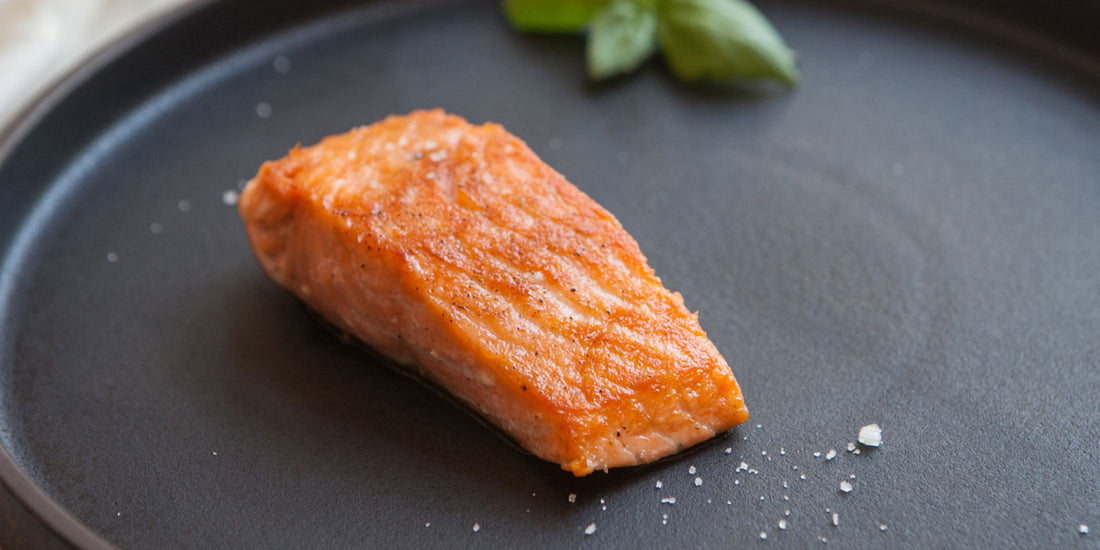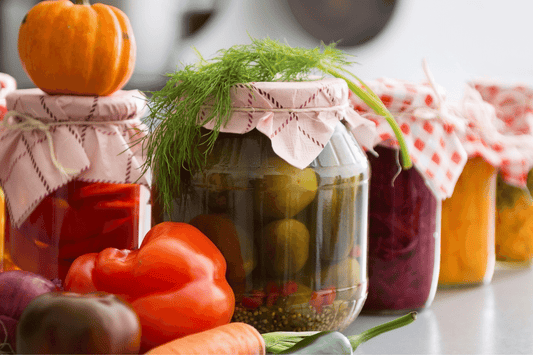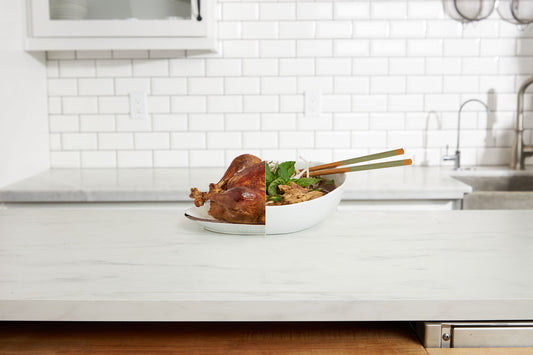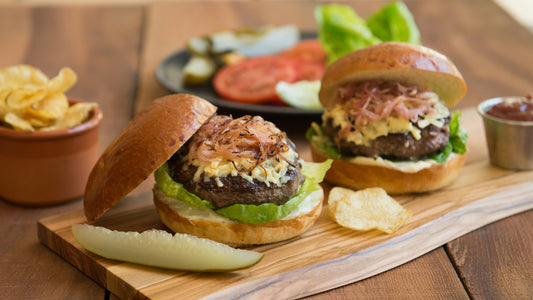By Julian Weisner, Culinary Scientist
Guide to Pan-Seared Salmon
The Secret to Foolproof Salmon
Our love for salmon is true and deep. It stems from the delicious fragrance wafting from the pan as you sear, and that texture, flavor, and versatility that makes it so easy to cook and enjoy. You can bake it, fry it, grill it, roast it; hell, you don’t even have to cook it! Aside from not cooking it at all, the next easiest and fastest way to get delicious salmon at home is definitely to pan searing.
Most recipes will give you a wide range of cooking times for the stove, but this leaves a lot of room for error, not to mention results aren't predictable or repeatable. To minimize error (and eliminate it entirely with Cue), we set out to find the perfect time and temp for every thickness of Atlantic salmon.
More than 550 fillets of salmon later and countless hours adjusting temperatures, flip methods, and timings, we've done just that. Read on, folks, we've got a boat load of info below to help you achieve flaky, mouthwatering salmon with Cue or a standard built-in stove.
-->Download the Printable Hestan Cue Time & Temp Chart for Pan-Seared Salmon<--
Cooking Salmon in a Pan
What's not to love about a fresh and flaky fillet of this fish? Not much. Unless, of course, that flaky fillet turns out dry and overcooked. We've all been there, but we don't have to stand for it. Unlike grilling or roasting in the oven, pan searing is fast and it allows you to dial in your fish to your favorite doneness, with precise temperature and timing, you can avoid error and nail it every time.

The Importance of Measuring the Thickness of Your Salmon Fillet
Most protein is sold in the store by weight. While this is an effective measure for gauging portion size, it is not the best tool for cooking. We’re sure you have read oven recipes that offer recommended times based on the size of your chicken, fish, or even pot roast, this is because the dimensions of these cuts roughly scale with weight. In reality, it is not the weight that is making your food cook slower, it is the physical size. While cooking the heat from your oven is trying to work all the way through your protein. For instance, if you were cooking a pot roast that was 10” thick by 10” long, or 14” long, it would still cook for the same amount of time because the thickness is the same, even though one must clearly weigh more; like everything else, heat will always take the path of least resistance.
Similarly two 5 ounce salmon fillets could cook completely different. A nice thick center cut salmon fillet will take much longer to cook than a thinner tail cut fillet, even though they are the same weight. This is why we ask for the thickness of your fish, not the weight.
Cooking Times for Pan-Seared Salmon
From our extensive research we have found that other types of salmon cook at a faster rate than Atlantic. For this reason, we recommend selecting the cook times corresponding to a ¼” less than your actual measured fillet. This in not an exact solution, but it will greatly benefit your outcome.
We also adjusted cooking times per side. Why cook for a different time per side, you may ask?
Texture! Texture is the difference between a brilliant well cooked piece of salmon and a drab monochromatic dinner. If your salmon had one homogenous texture you would be eating lox or sushi, but pan seared salmon is supposed to be hot and delicious, and a big part of that is texture. To do this we cook our salmon longer on the first side to ensure we can build color and texture, or for skin-on salmon, crispness; then we finish the salmon by cooking it lightly on the second side, so that most of the salmon can stay tender and flaky.
Temperature and Timing Charts for Pan Searing Atlantic Salmon
These charts cover three of the most popular styles of salmon, including skinless, skin-on salmon, and blackened salmon. The numbers are built for an average starting temperature of about 45°F (7°C), if you want to cook your salmon directly out of the fridge, you should add a little bit more cook time, likewise for salmon that you have taken the time to temper, you can decrease the cook time to get an even juicer result.
You should also account for resting time after you finish cooking your salmon. Consider the rest time an additional cook time and wait at least 5 minutes before eating. Salmon is pretty incredible in that it can increase up to 20°F(~10°C) while resting, so if you cut in early you may end up with something grossly undercooked!
Skinless Salmon Time & Temp Chart
For all types of cooking we use temperature as a tool to get the specific results we desire. For instance, for skin-on salmon we use high temperatures (450°F) to help release the skin from the pan and crisp it up; while with skinless salmon we can’t sear it as hot because there is no barrier between the delicate flesh and the pan. For this reason we use a lower temperature of 425°F in order to build color on our skinless salmon.
Cooking Skinless Salmon in a Pan
Place the salmon down onto the preheated pan and sear for 1 minute at 425°F (218°C). Then reduce the temperature to 400°F (204°C) and follow the guide for the recommended times to cook each side, based on the thickness and your desired doneness.
Crispy Skin Salmon Time & Temp Chart
We determined the temperatures for crispy-skin salmon by adjusting the pan degree by degree until the fish sizzled and popped like our chefs knew it should. After a lot of trial and error, we thought we had the temperatures dialed in to a consistent result. But the first step- crisping the skin- was inconsistent; sometimes the fish would stick and sometimes it wouldn't. We discovered that this was due to varying levels of drying the salmon before cooking. So we decided to raise the searing temperature to 450ºF (up from 425ºF), so that any residual moisture on the skin would quickly evaporate. This helps release the salmon from the pan and kick starts crisping the skin. However, the temperature for skinless salmon can remain at 425ºF.
Cooking Crispy Skin Salmon in a Pan
Start by placing the skin side of the salmon down onto the preheated pan and crisping for 1 minute at 450°F (232°C). Then reduce the temperature to 400°F (204°C) and follow the guide for the recommended times to cook each side, based on the thickness and your desired doneness.
Blackened Atlantic Salmon Time & Temp Chart
Blackened or crusted fish does not need to use high heat to build texture since it has a layer of seasoning and spice to do this for us. Instead we can focus on delicately bringing the salmon to our target temperature. In this case we cook our salmon at a moderate 375°F on both sides and for longer cooks, like Well Done, we even reduce the cooking temperature to 350°F in order to produce a moister result.
Cooking Crispy Skin Salmon in a Pan
Preheat your pan to the recommended temperature and cook your salmon on each side in the pan for the time recommended for your thickness and desired doneness. No searing is necessary.
For the Full Step-by-Step Recipes for Pan-Seared Salmon:
Precise Temperature Conversions for Stovetop Cooking
Standard stovetop settings are typically estimates that range between "low" "medium" and "high"–not precise, but we can work with it. We have accounted for this by converting precise temperatures to the approximate equivalent settings you'll find on your stovetop.We can’t promise the same results without the precise temperature provided by the Hestan Cue System, but you can still follow along and get some pretty darn good salmon using the temp conversion chart below.

FAQs for Pan-Cooked Salmon
Why do I need to dry the salmon thoroughly?
Since salmon has such a delicate flesh any extra moving or touching while it is cooking could damage it. By drying the fish thoroughly you will decrease how much it sticks to the pan, and will be able to slide your spatula easily underneath the fillet to flip your salmon.
Can I use this for fish other than salmon?
No, all fish are different, not just their sizes, but how they cook. But, feel free to request your favorite fish by following this link. We will have more fish guides coming your way in the future.
Can I use nonstick cookware to cook my Salmon?
Yes, however we recommend using the blackened or skinless methods, not the skin-on model. You can still cook skin-on salmon; however, high temperatures like 450°F, may damage your nonstick cookware. If you cook your skin-on salmon at a lower temp, you may need to cook it longer to crisp the skin.
Can I use Extra Virgin olive oil for pan-searing salmon?
Sadly, no. Extra virgin olive oil has a low smoke point that will burn with both of the pan seared recipes. You can refer to our Oil Guide to see where Extra Virgin Olive Oil falls. Luckily you can use light or refined olive oil which you can usually find at your grocery store. Or you can follow the guide for blackened salmon, and use EVOO, since it does not exceed 375°F.
How should I cook my salmon if I marinade it?
Use the blackened times and temperatures, with the pan-seared method (oil in the pan). Marinades often contain sugar or extra proteins which will cause the salmon to brown faster, by selecting the blackened method, you are less likely to burn your fish.
I cooked my salmon sous vide. Can I use the same times and temperatures to sear it when I finish it?
No, after sous vide cooking you don’t need to cook your salmon any more than it is. These times and temperatures will only ruin all of your hard work. Check out more from the Cue chefs in our Quick Guide to Searing Sous Vide Proteins
When should I season my salmon?
For salmon it is best to season shortly before cooking, as this will keep the fish as dry as possible before cooking.
Do I need to baste the salmon?
No, it is not necessary, but in general, basting can seriously help cook all of your fish more evenly, and we highly recommend doing so. Plus, basting with aromatics in the pan is a restaurant style technique that adds flavor and is sure to impress your friends and family.
Can I cook my salmon straight from the freezer?
No, these times and temperatures are designed for salmon either out of the refrigerator or after it has been tempered.
Can I reheat cooked salmon with these times and temperatures?
No, since your salmon is already cooked it will not need to spend nearly as much time to come back up to a servable temperature. Do yourself a favor and whip up something fun like a salmon salad or salmon tartine with your leftovers!
Keep us posted with photos of your experiments and share your results and #CueTips with the community!







